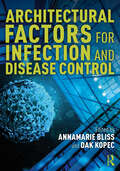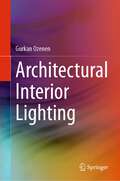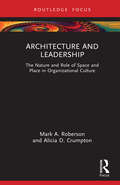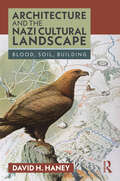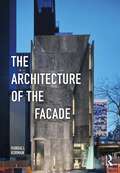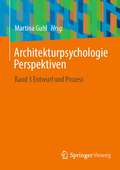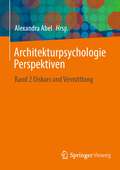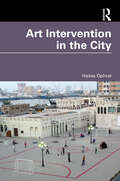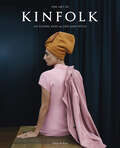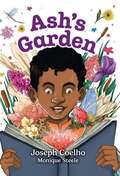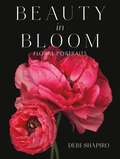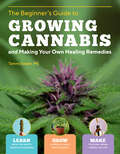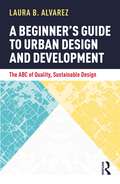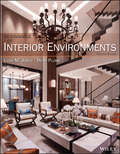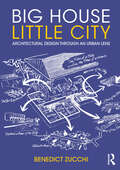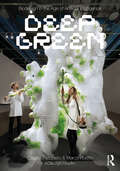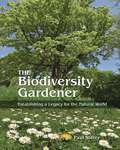- Table View
- List View
Architectural Factors for Infection and Disease Control
by AnnaMarie Bliss Dak KopecThis edited collection explores disease transmission and the ways that the designed environment has promoted or limited its spread. It discusses the many design factors that can be used for infection and disease control through lenses of history, public health, building technology, design, and education.This book calls on designers to consider the role of the built environment as the primary source of bacterial, viral, and fungal transfers through fomites, ventilation systems, and overcrowding and spatial organization. Through 19 original contributions, it provides an array of perspectives to understand how the designed environment may offer a reprieve from disease. The authors build a historical foundation of infection and disease, using examples ranging from lazarettos to leprosy centers to show how the ability to control infection and disease has long been a concern for humanity. The book goes on to discuss disease propagation, putting forth a variety of ideas to control the transmission of pathogens, including environmental design strategies, pedestrian dynamics, and open space. Its final chapters serve as a prospective way forward, focusing on COVID-19 and the built environment in a post-pandemic world.Written for students and academics of architecture, design, and urban planning, this book ignites creative action on the ways to design our built environment differently and more holistically.Please note that research on COVID-19 has exponentially grown since this volume was written in October 2020. References cited reflect the evolving nature of research studies at that time.
Architectural Interior Lighting
by Gurkan OzenenArchitectural Interior Lighting is an essential guide to creating well-lit, visually appealing interior spaces. The book begins with an overview of light and color theory, lighting fundamentals, and design principles. It then covers artificial, natural, decorative, and professional lighting in interior design, as well as standards and regulations, controls and systems, sustainable lighting, energy efficiency, light pollution reduction, and the use of environmentally friendly materials. With a focus on practical applications and real-world examples, this book provides readers with the tools and knowledge necessary to achieve their design goals while considering the latest trends and techniques in the field. A valuable resource for professionals and students in architecture and lighting design, it will also appeal to anyone interested in creating visually stunning and functional interior spaces.
Architecture and Leadership: The Nature and Role of Space and Place in Organizational Culture (Leadership Horizons)
by Mark A. Roberson Alicia D. CrumptonFrom cathedrals to cubicles, people go to great lengths and expense to design their living and working environments. They want their spaces to be places where they enjoy being, reflecting who they are and what they care about. The resultant environments in turn become loud, albeit unvocal, leaders for people occupying those corresponding spaces. The design and use of work and living spaces typifies and thematizes expectations for the group. Essentially, the architecture of rooms, buildings and cities creates cultures by conveying explicit and implicit messages. This is evident when people approach and walk into St. Basil’s Cathedral in Moscow, the Forbidden City in Beijing, the Sydney Opera House in Sydney, Australia, the Jewish Museum in Berlin, or the Rothko Chapel in Houston, to name some examples. While leaders oftentimes lack the resources to have their spaces mirror the greatest architectural achievements of the world, they are in a position to use the art and science of architecture, at whatever scale is available, to their advantage. The creative and intentional use of space and place advances and promotes cherished values and enhances organizational effectiveness. This book explores the essence of good architecture and establishes relevant connections for leaders and managers to strategically design and use the organizational workplace and space to support their mission and purpose, and create aesthetically meaningful work environments. It equips leaders to be culturally astute on what defines good architecture and to incorporate principles of beauty in their leadership practices accordingly and will be of interest to researchers, academics, professionals, and students in the fields of leadership, organizational studies, and architecture theory and practice.
Architecture and Leadership: The Nature and Role of Space and Place in Organizational Culture (Leadership Horizons)
by Mark A. Roberson Alicia D. CrumptonFrom cathedrals to cubicles, people go to great lengths and expense to design their living and working environments. They want their spaces to be places where they enjoy being, reflecting who they are and what they care about. The resultant environments in turn become loud, albeit unvocal, leaders for people occupying those corresponding spaces. The design and use of work and living spaces typifies and thematizes expectations for the group. Essentially, the architecture of rooms, buildings and cities creates cultures by conveying explicit and implicit messages. This is evident when people approach and walk into St. Basil’s Cathedral in Moscow, the Forbidden City in Beijing, the Sydney Opera House in Sydney, Australia, the Jewish Museum in Berlin, or the Rothko Chapel in Houston, to name some examples. While leaders oftentimes lack the resources to have their spaces mirror the greatest architectural achievements of the world, they are in a position to use the art and science of architecture, at whatever scale is available, to their advantage. The creative and intentional use of space and place advances and promotes cherished values and enhances organizational effectiveness. This book explores the essence of good architecture and establishes relevant connections for leaders and managers to strategically design and use the organizational workplace and space to support their mission and purpose, and create aesthetically meaningful work environments. It equips leaders to be culturally astute on what defines good architecture and to incorporate principles of beauty in their leadership practices accordingly and will be of interest to researchers, academics, professionals, and students in the fields of leadership, organizational studies, and architecture theory and practice.
Architecture and the Nazi Cultural Landscape: Blood, Soil, Building
by David H. HaneyThis book traces cultural landscape as the manifestation of the state and national community under the Nazi regime, and how the Nazi era produced what could be referred to as a totalitarian cultural landscape.For the Nazi regime, cultural landscape was indeed a heritage resource, but it was much more than that: cultural landscape was the nation. The project of Nazi racial purification and cultural renewal demanded the physical reshaping and reconceptualization of the existing environment to create the so-called "new Nazi cultural landscape." One of the most important components of this was a set of monumental sites thought to embody blood and soil beliefs through the harmonious synthesis of architecture and landscape. This special group of "landscape-bound" architectural complexes was interconnected by the new autobahn highway system, itself thought to be a monumental work embedded in nature. Behind this intentionally aestheticized view of the nation as cultural landscape lay the all-pervasive system of deception and violence that characterized the emerging totalitarian state.This is the first historical study to consider the importance of these monumental sites together with the autobahn as evidence of key Nazi cultural and geographic strategies during the pre-war years. This book concludes by examining racial and nationalistic themes underlying cultural landscape concepts today, against this historic background.
Architecture and the Nazi Cultural Landscape: Blood, Soil, Building
by David H. HaneyThis book traces cultural landscape as the manifestation of the state and national community under the Nazi regime, and how the Nazi era produced what could be referred to as a totalitarian cultural landscape.For the Nazi regime, cultural landscape was indeed a heritage resource, but it was much more than that: cultural landscape was the nation. The project of Nazi racial purification and cultural renewal demanded the physical reshaping and reconceptualization of the existing environment to create the so-called "new Nazi cultural landscape." One of the most important components of this was a set of monumental sites thought to embody blood and soil beliefs through the harmonious synthesis of architecture and landscape. This special group of "landscape-bound" architectural complexes was interconnected by the new autobahn highway system, itself thought to be a monumental work embedded in nature. Behind this intentionally aestheticized view of the nation as cultural landscape lay the all-pervasive system of deception and violence that characterized the emerging totalitarian state.This is the first historical study to consider the importance of these monumental sites together with the autobahn as evidence of key Nazi cultural and geographic strategies during the pre-war years. This book concludes by examining racial and nationalistic themes underlying cultural landscape concepts today, against this historic background.
The Architecture of the Facade
by Randall KormanThe Architecture of the Facade provides a comprehensive study of the facade as both a physical and cultural artifact, highlighting its significance as a critical component of the civic realm and arguing for the restoration of the art of the facade as both a subject of study within academia and an aspiration within the profession at large. As the principal surface of mediation, contextualization, and representation, the facade carries the lion’s share of responsibility for containing the internal environment and confronting the outer world. And yet, in recent decades, the very question of what exactly a facade is has been raised by the dramatic changes in building technology, advances of parametric design, and the ubiquity of autonomous buildings. The Architecture of the Facade addresses these and other related issues. The book is organized into 12 chapters, with each chapter focusing on a particular aspect of the phenomenon of the facade such as those of wall, the frame, transparency, and the role of the facade in civic space. Korman also discusses proportional systems, the language of composition, the role of precedent, the importance of context, and much more. Over 350 photos and diagrams provide readers with a variety of examples of artful facades throughout history. Online teaching resources that accompany this book include a course syllabus, a glossary, and a Pinterest tack board of facades. This book will be of great interest to students in architecture studios as well as instructors and professional architects interested in facade design.
The Architecture of the Facade
by Randall KormanThe Architecture of the Facade provides a comprehensive study of the facade as both a physical and cultural artifact, highlighting its significance as a critical component of the civic realm and arguing for the restoration of the art of the facade as both a subject of study within academia and an aspiration within the profession at large. As the principal surface of mediation, contextualization, and representation, the facade carries the lion’s share of responsibility for containing the internal environment and confronting the outer world. And yet, in recent decades, the very question of what exactly a facade is has been raised by the dramatic changes in building technology, advances of parametric design, and the ubiquity of autonomous buildings. The Architecture of the Facade addresses these and other related issues. The book is organized into 12 chapters, with each chapter focusing on a particular aspect of the phenomenon of the facade such as those of wall, the frame, transparency, and the role of the facade in civic space. Korman also discusses proportional systems, the language of composition, the role of precedent, the importance of context, and much more. Over 350 photos and diagrams provide readers with a variety of examples of artful facades throughout history. Online teaching resources that accompany this book include a course syllabus, a glossary, and a Pinterest tack board of facades. This book will be of great interest to students in architecture studios as well as instructors and professional architects interested in facade design.
Architekturpsychologie Perspektiven: Band 3 Entwurf und Prozess
by Martina GuhlWie findet die Begegnung von Psychologie und Architektur während des Entwurfs- und Planungsprozesses statt? In welchem Planungsabschnitt wird architekturpsychologisches Wissen relevant und einsetzbar? Welche Erkenntnisse liefert die urbane Architekturpsychologie für den städtebaulichen Diskurs? In diesem Buch bringen renommierte Expert*innen aus Deutschland, der Niederlande und der Schweiz aus den Disziplinen Architektur, Psychologie, Städtebau, Farbgestaltung und Kommunikationspsychologie ihr Pionierwissen ein.
Architekturpsychologie Perspektiven: Band 2 Diskurs und Vermittlung
by Alexandra AbelIn der gebauten und vom Menschen beeinflussten Umwelt manifestiert sich unser Leben: Lebenshaltung, Lebensformen, Lebensentwurf. Indem man Architektur neu denkt, hat man daher das Potential, die derzeitige Form unseres Lebens zu überdenken. Ein solches Neu, Anders braucht eine Sensibilisierung für die Relevanz der gebauten Umwelt, für die Werte und Zielgrößen, die hinter einer bestimmten Gestaltung stehen und braucht einen gesamtgesellschaftlichen Diskurs zu der zentralen Frage: Wie wollen wir leben? Wie dürfen wir leben? Vor dem Hintergrund ökologischer und ökonomischer Fairness: Welche Lebensformen sind kompatibel mit einer möglichst hohen Lebensqualität für uns alle, als Teil eines Ökosystems, mit dem unser Wohlbefinden unauflöslich verbunden ist. In diesem Band kommen namhafte Expertinnen aus Österreich, der Schweiz und Deutschland aus den Disziplinen der Architektur, der Psychologie, der Kunst und Kunstdidaktik zu Wort, die sich zu der Relevanz und zu den Voraussetzungen einer solchen Debatte äußern.
Art Intervention in the City
by Hadas OphratThis book focuses on the phenomenon of art intervention—an expression of local initiatives by artists, collectives, and art centers wishing to influence the design of the space or make a change in its lifestyle. It pertains not only to acts of protest, but also to the creation of a new civil and political situation in which artists acknowledge their ability to constitute foci of power. These are reflected in acts such as squatting in abandoned buildings, restoring and redistributing them according to principles of social justice; mapping the city based on alternative parameters, such as revealing venues of collective memory or exposing the city's backyard; creating outdoor urban art galleries; and creating temporary architecture and alternative solutions in order to deal with the challenges we face in times of epidemic and environmental crisis. The art intervention phenomenon has intensified since the mid-1990s, so much so that even local authorities the world over have begun to adopt activist and artistic practices. Due to the intensive urbanization processes and current global threats, the creative trends and means surveyed in the book are crucial. This book will interest researchers, planners, urban planners, architects, social activists, local authority executives, art centers, artists, and designers.
Art Intervention in the City
by Hadas OphratThis book focuses on the phenomenon of art intervention—an expression of local initiatives by artists, collectives, and art centers wishing to influence the design of the space or make a change in its lifestyle. It pertains not only to acts of protest, but also to the creation of a new civil and political situation in which artists acknowledge their ability to constitute foci of power. These are reflected in acts such as squatting in abandoned buildings, restoring and redistributing them according to principles of social justice; mapping the city based on alternative parameters, such as revealing venues of collective memory or exposing the city's backyard; creating outdoor urban art galleries; and creating temporary architecture and alternative solutions in order to deal with the challenges we face in times of epidemic and environmental crisis. The art intervention phenomenon has intensified since the mid-1990s, so much so that even local authorities the world over have begun to adopt activist and artistic practices. Due to the intensive urbanization processes and current global threats, the creative trends and means surveyed in the book are crucial. This book will interest researchers, planners, urban planners, architects, social activists, local authority executives, art centers, artists, and designers.
The Art of Kinfolk: An Iconic Lens on Life and Style
by John BurnsAn inspiring collection of the best images from the tastemaking Kinfolk magazine With over 650,000 copies of their books in print and nearly 50 issues of their magazine distributed worldwide, Kinfolk has come to define the taste of a generation: From interiors to fashion, portraiture, food and travel, the consistently boundary-pushing photography produced by the brand has coalesced into one of the most influential and immersive lifestyle aesthetics of the last decade. The Art of Kinfolk brings more than 300 of the most iconic images from the first decade of the magazine into focus. Ranging from the deceptively simple to the surreal to the perennially stylish, this collection of originally commissioned photography captures the arc of an artistic adventure, a creative community at work, and in the process illuminates one of the most enigmatic aesthetics of the era.
Beauty in Bloom: Floral Portraits
by Debi ShapiroA poppy bud captured moments before blossoming. A statuesque tuberose as if carved out of alabaster. A pair of delicate pink dahlias joined like two starfish floating in the sea.Beauty in Bloom is the debut collection of work by Debi Shapiro, a visual artist who creates beautiful imagery inspired by her two passions—flowers and photography. More than 200 floral portraits in this exquisite book capture the depth and luminosity of a single bloom to lush bouquets with breathtaking intimacy and vibrant energy. Every translucent petal, tender green stem, and grain of pollen shimmers with painterly detail reminiscent of the works of the great botanical artists and engravers of the eighteenth century. From the bold crimson beauty of an Oriental poppy to the seductive lure of a pink Protea peeking out from behind its thick foliage to the timeless classic beauty of a garden rose, it&’s a flower lover&’s dream. Debi&’s work truly makes every bloom a leading lady.
Beginner's Guide to Growing Cannabis and Making Your Own Healing Remedies: Learn about the Plant's Medicinal Properties; Grow Outdoors in Your Own Backyard; and Make Tinctures, Salves, Edibles, and Oils
by Tammi SweetAn herbalist and teacher offers an accessible and practical guide to growing cannabis outdoors for personal use, and preparing and using cannabis medicine for a range of common ailments. CBD and other cannabis-based products are widely available and popular, with the number of dispensaries increasing exponentially every month. But not all products are equal in terms of quality. The best rule of thumb to know the grower or, even better, grow a small quantity of the plant in the home garden and make your own medicines. This beginner-friendly guide, written by a herbalist who specializes in every aspect of making and using cannabis medicine, teaches how to grow healthy cannabis plants outdoors for personal use, and make your own customized remedies for addressing a range of common ailments and chronic conditions. With step-by-step photography taken in her own garden, author Tammi Sweet, shows the growing phases of the plant and details techniques for planting, caring for, harvesting, drying, and curing the plant. A complete how-to guide to medicine-making shows the reader how easy it is to make potent, safe, and affordable whole-plant tinctures, salves, edibles, and oils. This publication conforms to the EPUB Accessibility specification at WCAG 2.0 Level AA.
A Beginner's Guide to Urban Design and Development: The ABC of Quality, Sustainable Design
by Laura B. AlvarezThis book provides invaluable guidance to all those with an interest in placemaking and the built environment, from those with no experience to those who have worked for many years in industry, illustrating key principles that will secure higher quality, more sustainable design in accessible, jargon-free language. The author explains the design process in a straightforward way, exploring the different roles and highlighting the opportunities and limitations different agencies have to influence design over the various stages of the process. Examples from the UK and worldwide look at how the system operates and how best practice can make a real difference on the ground. Case studies examine situations where quality or sustainability fell short – and how this could have been avoided. This book also showcases a variety of evaluation tools, explaining how they operate, and giving guidance on how to create project-specific tools to drive schemes forward. With community empowerment at its core, the book explains technical language and shares bountiful knowledge to broaden place democracy and make influencing design accessible to many, not just a few. This is a book that brings together all the various parties involved in shaping the built environment, demonstrating that collaboration and mutual understanding are key to achieving better quality, more sustainable design.
A Beginner's Guide to Urban Design and Development: The ABC of Quality, Sustainable Design
by Laura B. AlvarezThis book provides invaluable guidance to all those with an interest in placemaking and the built environment, from those with no experience to those who have worked for many years in industry, illustrating key principles that will secure higher quality, more sustainable design in accessible, jargon-free language. The author explains the design process in a straightforward way, exploring the different roles and highlighting the opportunities and limitations different agencies have to influence design over the various stages of the process. Examples from the UK and worldwide look at how the system operates and how best practice can make a real difference on the ground. Case studies examine situations where quality or sustainability fell short – and how this could have been avoided. This book also showcases a variety of evaluation tools, explaining how they operate, and giving guidance on how to create project-specific tools to drive schemes forward. With community empowerment at its core, the book explains technical language and shares bountiful knowledge to broaden place democracy and make influencing design accessible to many, not just a few. This is a book that brings together all the various parties involved in shaping the built environment, demonstrating that collaboration and mutual understanding are key to achieving better quality, more sustainable design.
Beginnings of Interior Environments
by Lynn M. Jones Heidi PlumbThe new edition of the leading textbook remains the gold standard for interior design education. In this twelfth edition of Beginnings of Interior Environments, established interior designer and professor Lynn M. Jones, ASID, IDEC collaborates with innovator Heidi Plumb, IIDA, IDEC, to deliver a practical and balanced overview of commercial and residential interior design. Written to offer coverage of the creative and technical characteristics of the profession, the text also addresses Council for Interior Design Accreditation (CIDA) content. Part I opens with a discussion on the scope and value of the profession and includes a pictorial overview of the history of design. Subsequent parts cover design fundamentals, the spatial envelope—including space planning and systems—, products and materiality, and designing for a living. A new chapter addresses the art and science of visual communications. Hundreds of images from actual design projects, supplied by national and international design firms, illustrate quality examples. &“Precedent Studies&” include in-house production work from these practicing designers. Content, updated throughout, includes additional information on design thinking, inclusivity, WELL building standards, casework, and architectural millwork. New end-of-chapter self-directed projects provide students the opportunity to apply their knowledge. Written by two successful educators and practitioners, both NCIDQ certified with terminal degrees, the text applies a balance between education and practice. It is the ideal textbook for introductory interior design or interior architecture courses, and an invaluable resource for anyone looking to apply a holistic interior design perspective to their own home or business. As in previous editions, the text Introduces interior design with a foundation in its health, safety, and welfare benefits Explores design fundamentals, including visual literacy, and the elements and principles of design, with a special emphasis on color and now visual communications Discusses construction, including building components, codes, regulations, as well as lighting, electrical, and communication systems Offers an in-depth examination of the profession, including career pathways and professional organizations Reviews critical global issues such as sustainability, universal design, and culturally sensitive design Includes a dedicated section on interior materials and finishes—floorings, ceilings, wallcoverings, upholstery—and furnishings such as furniture, art, and accessories Leads students to analyze the needs of clients to design safe and sustainable environments that enhance the quality of life Includes a companion site for instructors featuring PowerPoint slides and an Instructor's manual with discussion points, objectives, lecture outlines, learning activities, and example quizzes with answers
Big House Little City: Architectural Design Through an Urban Lens
by Benedict ZucchiCombining architectural and urban thinking in an unusual and engaging way, this book presents an integrated approach to architectural theory and design. Leon Battista Alberti’s assertion in his famous Renaissance treatise that ‘the city is like a big house, and the house is in turn like a little city’ forms the springboard for a series of reflections on architecture’s relationship with urbanism and how their once intimate symbiosis, unravelled by International Style Modernism, can be recovered. Explicit references to Alberti’s house-city phrase have been made by figures as diverse as the architects Louis Kahn, Aldo Van Eyck, Denys Lasdun and Niels Torp and novelist Italo Calvino. But, as the book shows, thinking of buildings as little cities provides a new lens through which to reappraise the contributions of many other architects, including Le Corbusier, Frank Lloyd Wright, Alvar Aalto, Eliel Saarinen, Bernard Rudofsky, Hans Scharoun, Leon Krier, Fumihiko Maki, Charles Correa and Team 10. In doing so, the author identifies common themes that form an unexpected bridgehead between the urban and architectural approaches of Antiquity, the Middle Ages, Renaissance and 20th century. The book explores buildings from across the globe, including lesser-known projects, such as Wright’s unbuilt house in Italy or Saarinen’s master plan for Cranbrook Academy, as well as more recent projects by Niels Torp, Behnisch Architekten, Sou Fujimoto, Peter Barber and WOHA. It concludes with practical case studies of residential, health, education and workplace projects from different countries, fulsomely illustrated with many drawings and photographs. These show how architectural design viewed through an urban lens provides a conceptual framework for breaking down the scale of large buildings and integrating them with their context. And crucially, these also show a very accessible way of explaining evolving designs to the intended users and eliciting their participation in the design process. The book offers a compelling approach to the design of projects at all scales, within an ecological perspective: the sense that big and small, cities and buildings must be approached holistically if we are to reverse the degradation and depletion of our habitat, both natural and man-made.
Big House Little City: Architectural Design Through an Urban Lens
by Benedict ZucchiCombining architectural and urban thinking in an unusual and engaging way, this book presents an integrated approach to architectural theory and design. Leon Battista Alberti’s assertion in his famous Renaissance treatise that ‘the city is like a big house, and the house is in turn like a little city’ forms the springboard for a series of reflections on architecture’s relationship with urbanism and how their once intimate symbiosis, unravelled by International Style Modernism, can be recovered. Explicit references to Alberti’s house-city phrase have been made by figures as diverse as the architects Louis Kahn, Aldo Van Eyck, Denys Lasdun and Niels Torp and novelist Italo Calvino. But, as the book shows, thinking of buildings as little cities provides a new lens through which to reappraise the contributions of many other architects, including Le Corbusier, Frank Lloyd Wright, Alvar Aalto, Eliel Saarinen, Bernard Rudofsky, Hans Scharoun, Leon Krier, Fumihiko Maki, Charles Correa and Team 10. In doing so, the author identifies common themes that form an unexpected bridgehead between the urban and architectural approaches of Antiquity, the Middle Ages, Renaissance and 20th century. The book explores buildings from across the globe, including lesser-known projects, such as Wright’s unbuilt house in Italy or Saarinen’s master plan for Cranbrook Academy, as well as more recent projects by Niels Torp, Behnisch Architekten, Sou Fujimoto, Peter Barber and WOHA. It concludes with practical case studies of residential, health, education and workplace projects from different countries, fulsomely illustrated with many drawings and photographs. These show how architectural design viewed through an urban lens provides a conceptual framework for breaking down the scale of large buildings and integrating them with their context. And crucially, these also show a very accessible way of explaining evolving designs to the intended users and eliciting their participation in the design process. The book offers a compelling approach to the design of projects at all scales, within an ecological perspective: the sense that big and small, cities and buildings must be approached holistically if we are to reverse the degradation and depletion of our habitat, both natural and man-made.
Biodesign in the Age of Artificial Intelligence: Deep Green
by Claudia Pasquero Marco PolettoBiodesign in the Age of Artificial Intelligence: Deep Green investigates the potential of nature-based technology for shaping the evolution of contemporary architecture and design. It takes on the now pervasive topic of design intelligence, extending its definition to encompass both biological and digital realms. As in their first title, Systemic Architecture: Operating Manual for the Self-Organizing City, the authors engage the topic through the specific lens of their innovative design practice, ecoLogicStudio, and their research at the University of Innsbruck and at the Bartlett, UCL. Part One of the book, entitled PhotoSynthetica™, illustrates design solutions that engage the urban microbiome and seek to achieve an immediate impact, while Part Two, entitled Deep Green, includes synthetic landscapes and operates within a much larger spatio-temporal frame, going beyond human perception and life span to envision design as a geographical and geological force. In the age of catastrophic climate change, such perceptual expansion helps to clarify that change cannot simply be stopped or rolled back. We must instead establish more positive dynamics of change within the living world. To this end, this book proposes to engage with design and architecture as an extended cognitive interface, a sentient being that is co-evolutionary and symbiotic with the living planet, contributing to its beauty and to our continued enjoyment of it.
Biodesign in the Age of Artificial Intelligence: Deep Green
by Claudia Pasquero Marco PolettoBiodesign in the Age of Artificial Intelligence: Deep Green investigates the potential of nature-based technology for shaping the evolution of contemporary architecture and design. It takes on the now pervasive topic of design intelligence, extending its definition to encompass both biological and digital realms. As in their first title, Systemic Architecture: Operating Manual for the Self-Organizing City, the authors engage the topic through the specific lens of their innovative design practice, ecoLogicStudio, and their research at the University of Innsbruck and at the Bartlett, UCL. Part One of the book, entitled PhotoSynthetica™, illustrates design solutions that engage the urban microbiome and seek to achieve an immediate impact, while Part Two, entitled Deep Green, includes synthetic landscapes and operates within a much larger spatio-temporal frame, going beyond human perception and life span to envision design as a geographical and geological force. In the age of catastrophic climate change, such perceptual expansion helps to clarify that change cannot simply be stopped or rolled back. We must instead establish more positive dynamics of change within the living world. To this end, this book proposes to engage with design and architecture as an extended cognitive interface, a sentient being that is co-evolutionary and symbiotic with the living planet, contributing to its beauty and to our continued enjoyment of it.
The Biodiversity Gardener: Establishing a Legacy for the Natural World (Wild Nature Press #34)
by Paul SterryA personal account of—and guide to—unlocking the wildlife potential of gardens and other plots of land in lowland BritainOver the past decade, wildlife author and photographer Paul Sterry has nurtured, both through action and by doing nothing, what has become a small island of flourishing biodiversity in the half-acre garden that surrounds his north Hampshire cottage. By giving nature a free hand, and fostering habitats appropriate to this part of southeast England, he has enabled an abundance of native plant and animal species to call the garden home. This contrasts with the continued decline in biodiversity in the surrounding countryside. In this inspiring and informative book, Sterry tells the story of his own experiences in biodiversity gardening and offers detailed practical advice to anyone who wants to give nature the upper hand on their own bit of land, no matter how small.Hampshire still retains traces of its rich wildlife heritage, but changes in land use over the past half-century have had a devastating impact on local biodiversity. Against this backdrop, The Biodiversity Gardener presents a habitat-driven and evidence-based approach, describing how any gardener can unlock the wildlife potential of their plot and enjoy the satisfaction of watching it become home to a rich array of native species, including butterflies, wildflowers, grasshoppers, amphibians, and fungi.In The Biodiversity Gardener, Sterry explains the ecological imperative of adopting this approach. Collectively, biodiversity gardens could leave a lasting legacy—wildlife oases from which future generations stand a fighting chance of restoring Britain’s natural heritage. The book encourages and empowers readers to create their own biological inheritance for posterity—and shows them how they can do it.
British and Irish Wild Flowers and Plants: A Pocket Guide (WILDGuides #117)
by Robert Still Chris Gibson Rachel HamiltonA highly illustrated and portable identification guide to the most common wild flowers and other plantsThis innovative photographic guide covers the most common wild flowers and other plants found in Britain and Ireland, as defined by the very latest distribution maps. It is designed so that anyone faced with an unfamiliar wild plant can confidently put a name to the species or recognise that it is a less common plant needing further investigation. The identification process is based on standard botanical features that are straightforwardly described, clearly illustrated and supported by a simple visual key to families. This book can be your springboard into the wider world of botanical identification, wherever you are, and of plants both common and rare.Covers the plants most likely to be seen, including those in coastal areasIncludes more than 3,800 colour photographs, with macro images of key features when neededFeatures a friendly, easy-to-use design and text written in plain English, with essential botanical terms described and illustrated
